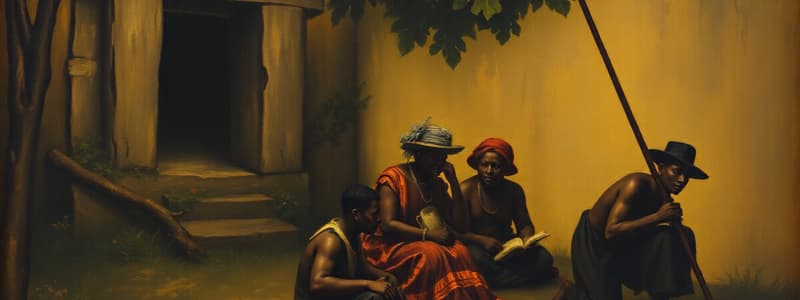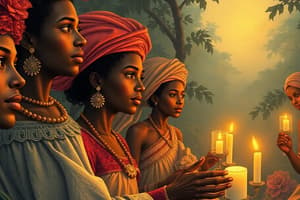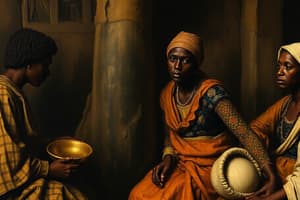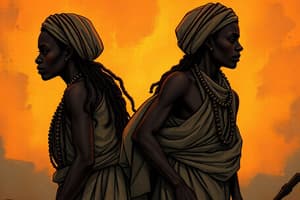Podcast
Questions and Answers
Enslaved people in the English colonies initially arrived in Virginia around ______, marking the beginning of a long period of forced labor.
Enslaved people in the English colonies initially arrived in Virginia around ______, marking the beginning of a long period of forced labor.
1619
By the mid-1700s, ______ was legalized across all colonies, solidifying its presence as a widespread practice.
By the mid-1700s, ______ was legalized across all colonies, solidifying its presence as a widespread practice.
slavery
Enslaved people demonstrated resistance against their bondage through various means, including rebelling, damaging tools, feigning ______, and intentionally slowing down their work.
Enslaved people demonstrated resistance against their bondage through various means, including rebelling, damaging tools, feigning ______, and intentionally slowing down their work.
illness
Despite lacking freedom of expression against slavery, enslaved people upheld their cultural heritage through storytelling and songs about ______.
Despite lacking freedom of expression against slavery, enslaved people upheld their cultural heritage through storytelling and songs about ______.
Besides overt forms of resistance, enslaved people preserved their cultural identity by singing songs, playing the banjo, and sometimes playing a ______, maintaining a connection to their African heritage.
Besides overt forms of resistance, enslaved people preserved their cultural identity by singing songs, playing the banjo, and sometimes playing a ______, maintaining a connection to their African heritage.
To oversee enslaved people, plantation owners commonly employed a(n) ______ to supervise their labor and enforce discipline.
To oversee enslaved people, plantation owners commonly employed a(n) ______ to supervise their labor and enforce discipline.
The traders brought millions of Africans to North America, South America and the ______.
The traders brought millions of Africans to North America, South America and the ______.
Families were often broken apart and sold to ______ owners.
Families were often broken apart and sold to ______ owners.
Many enslaved people ran away to escape ______, but those who escaped were often caught and returned to their owners.
Many enslaved people ran away to escape ______, but those who escaped were often caught and returned to their owners.
Small farms in the Southern colonies were often far away from each other, so ______ services became major social events.
Small farms in the Southern colonies were often far away from each other, so ______ services became major social events.
The Seminole tribe is known for giving runaway people food and ______, and some began dressing like the Seminole.
The Seminole tribe is known for giving runaway people food and ______, and some began dressing like the Seminole.
Runaways that dressed like the Seminole and learned their language became known as ______ Seminoles.
Runaways that dressed like the Seminole and learned their language became known as ______ Seminoles.
Most owners of small farms did not own enslaved people, those who did worked alongside their ______ workers but did not treat them as equals.
Most owners of small farms did not own enslaved people, those who did worked alongside their ______ workers but did not treat them as equals.
To escape slavery, many enslaved people ran away with some finding sanctuary in Spanish ______ and were helped by Native American tribes.
To escape slavery, many enslaved people ran away with some finding sanctuary in Spanish ______ and were helped by Native American tribes.
The Seminole tribe gave runaways land if they gave back one-______ of the crop they raised on it.
The Seminole tribe gave runaways land if they gave back one-______ of the crop they raised on it.
Eliza Lucas ______ moved to South Carolina with her parents in 1738.
Eliza Lucas ______ moved to South Carolina with her parents in 1738.
The Southern Colonies' economy heavily relied on ______, without which the plantation system wouldn't have been viable.
The Southern Colonies' economy heavily relied on ______, without which the plantation system wouldn't have been viable.
Planters often hired tutors to educate their children at home, while ______ were prohibited from attending school.
Planters often hired tutors to educate their children at home, while ______ were prohibited from attending school.
Planters managed plantations but typically did not directly engage in the labor; instead, ______ performed the work.
Planters managed plantations but typically did not directly engage in the labor; instead, ______ performed the work.
Planters occasionally served their communities as judges or members of the colonial assembly, highlighting their role in ______.
Planters occasionally served their communities as judges or members of the colonial assembly, highlighting their role in ______.
Some enslaved people maintained small gardens near their homes, cultivating them in their limited free time after ______.
Some enslaved people maintained small gardens near their homes, cultivating them in their limited free time after ______.
The initial plantations were established along the Coastal Plain, but by 1750, settlers had moved westward, developing expansive plantations ______.
The initial plantations were established along the Coastal Plain, but by 1750, settlers had moved westward, developing expansive plantations ______.
Although large plantations produced most of the crops, many colonists lived and worked on ______.
Although large plantations produced most of the crops, many colonists lived and worked on ______.
Despite not wanting to be part of the system of slavery, some free Africans did ______.
Despite not wanting to be part of the system of slavery, some free Africans did ______.
After experimenting with indigo, Eliza Lucas Pinckney helped make indigo a major ______ in South Carolina by the 1740s.
After experimenting with indigo, Eliza Lucas Pinckney helped make indigo a major ______ in South Carolina by the 1740s.
The Southern Colonies relied on ______ like Charles Town to export their cash crops to markets in England and the West Indies.
The Southern Colonies relied on ______ like Charles Town to export their cash crops to markets in England and the West Indies.
Due to the warm and wet climate, southern North Carolina, South Carolina, and Georgia were suitable for growing ______, which became a major cash crop.
Due to the warm and wet climate, southern North Carolina, South Carolina, and Georgia were suitable for growing ______, which became a major cash crop.
Farmers in Maryland, Virginia, and northern North Carolina primarily grew ______ as their main cash crop, which required many workers and a lot of land.
Farmers in Maryland, Virginia, and northern North Carolina primarily grew ______ as their main cash crop, which required many workers and a lot of land.
Rice in South Carolina was so important it was often called '______', reflecting its economic value to the region.
Rice in South Carolina was so important it was often called '______', reflecting its economic value to the region.
Indigo plants produced a blue ______ that was essential in the clothmaking process, making it a valuable commodity for the Southern Colonies.
Indigo plants produced a blue ______ that was essential in the clothmaking process, making it a valuable commodity for the Southern Colonies.
After about seven years, tobacco plants deplete the ______ in the soil, causing farmers to clear more land for new crops.
After about seven years, tobacco plants deplete the ______ in the soil, causing farmers to clear more land for new crops.
Eliza Lucas Pinckney experimented with ______ seeds sent by her father to develop a high-quality dye crop.
Eliza Lucas Pinckney experimented with ______ seeds sent by her father to develop a high-quality dye crop.
Flashcards
Plantation System
Plantation System
Economic system based on large farms growing cash crops like tobacco and cotton.
Planters' Wealth
Planters' Wealth
Cash crops produced by enslaved workers made some plantation owners very wealthy.
Planters' Roles
Planters' Roles
Planters ran plantations, often also serving as judges or in colonial assemblies.
Plantation Workshops
Plantation Workshops
Signup and view all the flashcards
Overseer's House
Overseer's House
Signup and view all the flashcards
Enslaved People's Homes
Enslaved People's Homes
Signup and view all the flashcards
Enslaved People's Gardens
Enslaved People's Gardens
Signup and view all the flashcards
Enslaved Education
Enslaved Education
Signup and view all the flashcards
Transatlantic Slave Trade
Transatlantic Slave Trade
Signup and view all the flashcards
Enslaved People
Enslaved People
Signup and view all the flashcards
Southern Colonies
Southern Colonies
Signup and view all the flashcards
Abuse of Enslaved People
Abuse of Enslaved People
Signup and view all the flashcards
Resistance to Slavery
Resistance to Slavery
Signup and view all the flashcards
Preserving Culture
Preserving Culture
Signup and view all the flashcards
Christian Religion
Christian Religion
Signup and view all the flashcards
Overseer
Overseer
Signup and view all the flashcards
Escape from Slavery
Escape from Slavery
Signup and view all the flashcards
Church in Southern Colonies
Church in Southern Colonies
Signup and view all the flashcards
Seminole Tribe's aid
Seminole Tribe's aid
Signup and view all the flashcards
Black Seminoles
Black Seminoles
Signup and view all the flashcards
Southern Colonists' Livelihood
Southern Colonists' Livelihood
Signup and view all the flashcards
Small Farm Owners
Small Farm Owners
Signup and view all the flashcards
Small farms relationships
Small farms relationships
Signup and view all the flashcards
Eliza Lucas Pinckney
Eliza Lucas Pinckney
Signup and view all the flashcards
Cash Crops
Cash Crops
Signup and view all the flashcards
Southern Seaports
Southern Seaports
Signup and view all the flashcards
Tobacco
Tobacco
Signup and view all the flashcards
Tobacco Plantation Problems
Tobacco Plantation Problems
Signup and view all the flashcards
Carolina Gold
Carolina Gold
Signup and view all the flashcards
Indigo
Indigo
Signup and view all the flashcards
Southern Climate
Southern Climate
Signup and view all the flashcards
Study Notes
Slavery and Society
- Traders brought millions of Africans to North America, South America, and the Caribbean for over 300 years.
- These Africans were taken from their homes, chained in ships, and then sold into slavery.
Treatment of Enslaved People
- The first Africans likely arrived in the English colonies in Virginia in 1619.
- Initially, English colonies used indentured servants as workers before transitioning to slavery.
- As more workers were needed, colonial governments legalized slavery.
- By the mid-1700s, slavery was legal in every colony.
- Laws declared that children born to enslaved people were also enslaved.
- Families were often separated and sold to different owners.
- In the Southern Colonies, most enslaved Africans worked on plantations.
- Treatment varied by owner; enslaved people were often beaten and abused.
- Escape was difficult but attempted.
- Speaking out against slavery was prohibited, but enslaved people resisted through rebellion, sabotage, feigning illness, or working slowly.
- Punishment for resistance was harsh.
- Enslaved people preserved their culture through storytelling and song.
- By the late 1700s, Christianity became a source of strength for some.
- Music was an important part of enslaved people's culture, involving songs, drums, and banjos.
- Some played the kalimba, or thumb piano.
A Farming Economy
- The Southern Colonies' economy was based on plantations, relying on enslaved labor.
- Cash crops produced by enslaved workers made plantation owners wealthy.
- Plantations were initially built along the Coastal Plain, with westward expansion by 1750.
- Plantation size grew with the planters' wealth.
- Some plantations resembled small villages.
- Plantations included workshops where enslaved people made nails, bricks, barrels, and other essential items.
- Plantation owners employed an overseer to supervise enslaved people.
- The overseer's house was usually near the fields, while enslaved workers' houses were farther from the planter's.
- Enslaved people maintained small gardens near their homes.
- Planters managed the plantations but did not perform the manual labor.
- Planters sometimes served as community judges or colonial assembly members.
- Many hired teachers to educate their children at home.
- Enslaved children were not allowed to attend school.
- It as illegal for enslaved people to learn to read or write with punishment if they were caught.
Life on Small Farms
- The Southern Colonies' economy relied mostly on crops from large plantations.
- Most colonists lived and worked on small farms.
- Former indentured servants often became small farm owners, but most did not become rich.
- Most small farm owners did not own enslaved people.
- Some did own enslaved people and worked alongside them but did not treat them as equals.
- Church services were major events because small farms were far apart.
- Families traveled for hours to attend church, where they socialized.
Free Africans
- Some Africans bought their freedom and started farms.
- Most did not want to participate in slavery.
- Some free Africans bought relatives to free them.
- Many enslaved people ran away to escape slavery and were often caught and returned.
- Some found refuge in Spanish Florida or were helped by Native American tribes.
The Black Seminoles
- The Seminole tribe provided runaway enslaved people with food and shelter.
- They gave runaways land in exchange for one-third of the crops.
- Many runaways adopted Seminole dress and language, becoming known as Black Seminoles.
Cash Crops
- Seaports like Charles Town were crucial to the Southern Colonies' economy.
- Plantations produced large quantities of cash crops that needed to be shipped to England and the West Indies.
- Different colonies grew different crops based on climate.
- The main cash crop in Maryland, Virginia, and northern North Carolina was tobacco.
- Tobacco cultivation required many workers and extensive land.
- Tobacco plants depleted soil nutrients after about seven years.
- In southern North Carolina, South Carolina, and Georgia, the climate was too warm and wet for tobacco, so farmers grew rice.
- Rice became a major cash crop in South Carolina, known as "Carolina gold".
- Indigo plants, which produce a blue dye, were grown on drier land.
- Indigo became an important cash crop after Eliza Lucas Pinckney's experiments with the plant.
- By the 1740s, indigo was a major cash crop throughout South Carolina.
- Eliza Lucas Pinckney moved to South Carolina with her parents in 1738.
- Her father returned to the West Indies when she was sixteen years old.
- Eliza started experimenting with indigo seeds sent by her father, working very hard.
- After three years, she successfully grew an indigo plant that produced excellent dye.
- Eliza gave seeds to neighbors and friends who began to grow it too.
- Within a few years, South Carolina planters were selling one million pounds of the dye to clothmakers throughout Europe.
The Economy Grows
- Plantations were self-sufficient but relied on merchants for some goods and services.
- Traders and merchants depended on plantations for cash crops and raw materials.
- Interdependence: depending on one another for economic resources
- As plantations expanded, more cash crops were exported by the owners of large plantations, often sold through a broker.
- Brokers are paid to buy and sell crops and bought the goods the planters wanted.
- Location affected plantation success; the most successful were near rivers or ports.
- Location also influenced city growth; by the mid-1700s, southern Atlantic coastal towns like Norfolk and Savannah became large cities.
- Baltimore, Maryland, was founded in 1729 on the Patapsco River, which flows into Chesapeake Bay.
- Baltimore exported grain and tobacco.
- Baltimore became a major shipbuilding center and developed the Baltimore clipper, one of the fastest sailing ships.
- Although farming predominated, the Southern economy also included other industries.
- Forests were vital natural resources, aiding Wilmington, North Carolina.
Studying That Suits You
Use AI to generate personalized quizzes and flashcards to suit your learning preferences.




